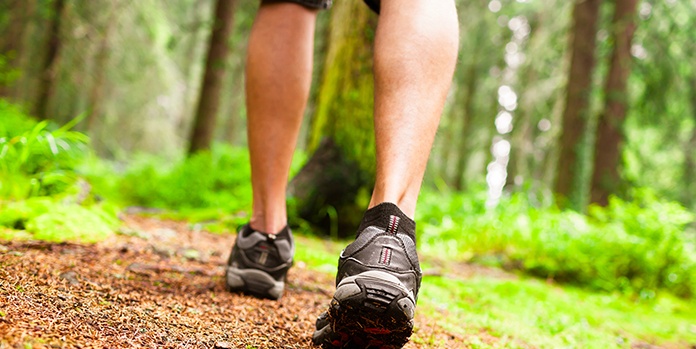Strength Exercises Eradicate Knee Pain When Hiking

Having knee pain while hiking can leave you demoralized and fearful of moving. Daily knee pain can make it difficult do daily activities like climbing stairs or even walking.
North and West Vancouver are prime destinations for hiking because the mountains are very accessible. Some of our clients live next door to several different trails and enjoy this activity from the spring up until the first snowfall.
Knee pain while hiking can largely be prevented and resolved with proper exercise progressions. Another alternative is to find easier trails with less climbing by searching sites like Vancouver Trails by difficulty.
Chronic knee pain, not associated with direct trauma such as a fall or twist, is often a result of long-term muscle imbalances. If you are experiencing pain that is either getting worse or not getting any better, have your doctor or physiotherapist assess it. As Kinesiologists, we look at the entire chain of movement. This means watching clients move while doing strength and flexibility tests to discover where muscle imbalances are.
Assessments include overhead squats and single-leg squats. Some things that show up are weak outer hips/tight inner hips, tight hip flexors/weak glutes, weak quadriceps/tight hamstrings and tight calf muscles.
When these movements are not completed in a balanced and optimal manner, we first address any muscle tightness or weakness to develop smoother, more functional movement patterns. This is much before any type of loading is done; body weight is often enough.
Areas to Focus On: Quadriceps, Hamstrings, Calves, Glutes and Upper Body. The following are some suggestions. Remember to let joint pain be your guide; be aware of your own limits and start gradually. A little muscle discomfort is a sign that you are challenging your body; it is when you rest the following day that your body adapts. This is a beginner program for those who are new to weight training or are rehabilitating from an injury. We suggest that anyone unfamiliar with these exercises hire a Kinesiologist to guide them with proper form.
Beginner Strength Program to Eliminate Knee Pain When Hiking
(4 weeks):To fatigue (when form fails), 1-3 sets, 60-second rest between sets or complete as a circuit. 2-3 days per week with one day of rest, e.g., cardio or light physical activity, in between.
- Side Lying Leg Raises: Lie on your side. Keep your ribs lifted and your core in neutral. Your hips are stacked on top of each other and your bottom leg is bent. Exhale to lift the top leg up towards ceiling and slightly behind, inhale to lower. Tip: Complete this with your back to a wall. Gently press your heel against the wall while lifting and lowering.
- Clams: Start is the same as above, but with both knees bent and heels touching. Exhale to raise the top knee up, keeping the heels together. Don’t rotate hips.
- 4-Point Kneeling or Pointed Dog: Start on your hands and knees; hands under shoulders, knees under hips. Keep your pelvis in neutral and engage your core. Exhale to reach one leg back. Focus on using your buttocks to raise the leg only as far as neutral is maintained. Alternate sides. Bend your arms, placing the forearms on the mat. Lie on a ball if it’s difficult for your wrists.
- Shoulder Bridge: Lie on your back with your arms by your side, knees bent, and heels hip-distance apart and slightly in front of the knees. Keeping your spine in neutral, exhale to use your glutes (buttocks) to raise the hips; inhale to relax your glutes and lower. Be aware of any rotation of the pelvis or if the knees are dropping or moving out to the side. Keep legs parallel to each other.
(4 weeks)12-15 reps, 1-3 sets, 60-second rest between sets or complete as circuit. 2-3 days per week with one day of rest , e.g., cardio or light physical activity in between.
- Stability Ball Wall Squats
- Seated Leg Curls or Lying Leg Curls (single-leg)
- Leg Press (single-leg) – keep legs parallel, finish with a slight bend in leg.
- Standing Calf Raise (body weight)
- Leg Extension (single-leg) – use the thigh to lift the bar up. Finish with a slight leg bend.
- Stiff Leg Deadlift (body weight, use a dowel or broomstick to start)**
- Stationary Lunges or Step-Ups
Progress gradually by adding 5% resistance when the last repetition is easy. Try using 5-lb dumbbells for the step-ups or lunges.We recommend single-leg because strength imbalances show up. If one side is noticeably stronger, try one set for the stronger side and two to three for the weaker side.
Hip and thigh strength are important to develop for hiking. The hip drive is used to propel you up the mountain while strong thighs are especially needed to prevent too much loading when going downhill.
** Many people have difficulty completing the proper hip hinge. Stiff Leg Deadlifts need to be done with the spine straight, and the core engaged. Lifting is done with the hamstrings and glutes. We often see this exercise done incorrectly in the gym. Hire someone to teach you and watch this Video of a proper Romanian dead lift.
Contact us to get an individualized exercise program to help you prevent knee pain when hiking
Other Related Post: Simple Tips to Get Moving with Knee Osteoarthritis






